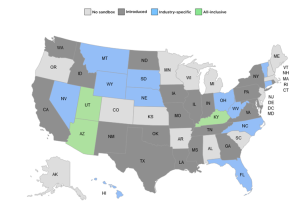In the race between states to promote economic development, Kansas hasn’t even left the starting line when it comes to a new innovative policy. Looking at the below map of the 50 states created by the Libertas Institute, Kansas is in the minority of states that haven’t enacted something called a regulatory sandbox. However, its always the right time to do the right thing. In this case, offer some regulatory relief to innovative companies and technologies.
What is a regulatory sandbox?
Before we define what a “regulatory sandbox” is, we need to understand why regulatory reform is needed in the first place.. Every business venture starts as an entrepreneur’s idea that hopefully develops into a successful business. In the short run though, starting a business is a massive financial investment, and 65% of new businesses close within their first ten years if they’re unable to find a niche in the market. Reducing businesses’ costs helps keep their doors open and may incentivize entrepreneurs to finally make the leap and try out their ideas.
Some of the largest costs that businesses and their workers face are from regulations. It would take the average person 185 hours to read through all of Kansas’s administrative regulations. A small business opening its doors faces an average of $83,000 in first-year regulatory costs. The cost to businesses adjusting to federal regulations was estimated to be $1.9 trillion as businesses adjust their model and strategies to conform. In Kansas alone, an estimated 29,409 jobs have been lost due to occupational licensing restrictions creating costs that keep workers out of the job market or force owners to make tough decisions about hiring and hours.
A regulatory sandbox is a set of rules that are timebound, typically for 2 to 3 years. These rules, or a waiver of rules, allow businesses to operate under fewer regulations. There are a number of reasons why this is beneficial. The simplest one is that regulations have a cost of compliance, so fewer regulations mean fewer costs for a business. New businesses thrive off innovation and offering a new product. According to MIT research, companies were less likely to expand and innovate as they approached an employee threshold that would have subjected them to new regulations. Operating under fewer regulations could allow businesses to experiment with new procedures and methods while not fearing new costs.
Sandboxes are beneficial to the government too. Fewer regulations means less cost for the administration of regulations themselves. Opponents of the idea of loosened regulations are quick to accuse the process of throwing safety out the window, but it’s the opposite in fact. The regulations that are lessened are agreed upon beforehand by both parties; all notions of safety aren’t just tossed out the window. In fact, government continually monitors how businesses operate in a sandbox.
Sandboxes Success
Sandboxes have had continued success in their implementation across the country, varying from industry-specific sandboxes to large-scale programs across a state’s entire economy.
Here’s an example of how a sandbox works. In 2019 in Utah, the legislature passed a law called the 30/70 rule that said mergers between title companies and brokerages could occur so long as 30% of the title company’s business is from unaffiliated business. However, this number has proved hard to reach for businesses. So, they applied to participate in a financial services sandbox to show that a merger isn’t a bad deal and that they’re able to operate without the 30/70 rule. While there isn’t a direct mechanism to analyze a sandbox’s duration, the experience of companies in a sandbox is supposed to help regulators make decisions about what statutes to keep and what to change.
Utah has been the shining example of sandbox success. For instance, the Utah Supreme Court unanimously approved expanding the “legal regulatory sandbox” environment for five more years due to successes the state has seen with innovative legal services such as online providers and bilingual medical debt counselors. It’s no surprise that Utah has topped the list of states in terms of economic growth. The Beehive State is tied with Washington for a Real GDP growth rate of 3.4% in the last quarter of 2019, just before the COVID-19 pandemic.
Industry-specific sandboxes abound too and allow states to carve out new specialties. In 2023, Kansas’s neighbor of Nebraska passed an insurance regulatory sandbox. In 2019, Arizona was the first state to do a property technology sandbox, which removed barriers to entry to the real estate industry. This legislation was just the start for Arizona, which then passed universal license recognition and Right to Try legislation for experimental medical treatments soon after.
Agricultural Sandboxes
An industry-specific sandbox that Kansas would be apt to adopt is one focused on agriculture – an area ripe for new innovation (no pun intended). Vertical farming or rooftop farms in urban areas may similarly be restricted by regulations. Similarly, farmers could be struggle with regulations that make it hard to advertise their business, such as selling raw milk.
Agriculture has a number of new technologies that can be introduced in a sandbox before they are cramped with regulations. Laser scarecrows keep birds away from crops by shining harmless green light at them. Self-driven tractors and drones to perform farm work are also possibilities. New tools to test soil quality and use GPS to predict farming yields could be seamlessly introduced via a sandbox. In Mississippi, a 2021 sandbox bill has ushered in a new wave of tools like DNA soil sampling and drone crop analysis.
Kansas needs to catch up on innovation and help businesses in their search for new opportunities. Sandboxes is a slam dunk way to do that which has widespread adoption in various forms across the country. Adopting such legislation would be a step away from the ineffective approach towards subsidies that Kansas has pursued instead.






